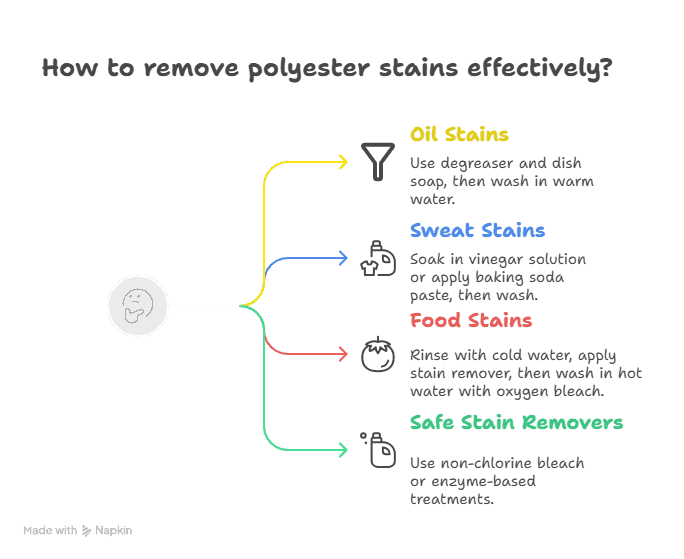Introduction-
Polyester is one of the most popular synthetic materials in the world. It is made from petroleum-based fibers that are known for their durability, wrinkle resistance, and versatility. You can find polyester in clothing, upholstery, bedding, sportswear, and even curtains. Due to its widespread use, many people wonder how to care for it properly. So, can you wash polyester?
The short answer is yes, polyester can be washed at home. However, it must be cared for properly to maintain its shape, softness, and bright colors. Incorrect washing can lead to damage such as pilling, shrinkage, or loss of fabric strength. If you follow the correct washing methods, polyester can look like new for years.
Can You Wash Polyester in a Washing Machine?
Yes, polyester can be machine washed and is thus convenient to take it everywhere during the day. Unlike finer fabrics like silk or wool, polyester is actually able to withstand repeat washings. Nonetheless, it is worth taking caution to avoid damage to the fabric by applying the proper settings.
Washing polyester at cold or warm water is the most appropriate way. Fibers could be weakened by hot water or they may shrink with time. Delicate cycle or a gentle cycle is the most suitable, because it is less agitating, and does not cause pilling. It is important to wash polyester garments along with like fabrics in order to prevent friction with rougher fabrics.
Best Washing Machine Settings
During machine washing polyester, add cold or warm water. Choose a gentle or permanent-press cycle. The settings below reduce fabric stress. Adding a fabric-safe detergent increases the cleaning power without weakening of the fibers.
Tips to Prevent Damage
Preventing snags, polyester clothes should be turned inside out before getting washed. Delicates made of polyester, like blouses or sports wear must be put in mesh laundry bags. This stops tangles with zippers, buttons or scratchy fabrics that could cause pulls.
Hand Washing Polyester (When & How)
Hand washing is useful for very delicate polyester pieces. For example, if an item has lace, beading, or says “hand wash” on the label, wash it by hand. This is also true for stretchy polyester-spandex activewear, which can lose elasticity if treated roughly. Use cool or lukewarm water and a mild detergent, and swish gently.
When to Hand Wash
Use hand washing for delicate polyester fabrics. For example, sheer blouses, lingerie or swimwear with embellishments should be washed by hand. Also, wash polyester-spandex athletic clothing by hand, since the stretchy fibers are heat-sensitive. If the care tag says “Hand wash,” follow it. Otherwise, sturdier polyester garments can safely be machine washed.
Handwashing Steps
- Fill a basin with cool water and a mild detergent.
- Swish the garment gently and let it soak for 5–10 minutes.
- Drain and rinse the garment under cool water until all detergent is gone.
- Press out excess water gently (do not wring) and lay the garment flat or hang it to dry.
Best Detergents for Washing Polyester
Usually fabric made of polyester is supposed to be cleaned using an ordinary detergent. The synthetic fibers are prone to damage, harsh detergent or bleach can ruin them. A soft liquid laundry detergent is optimum. Use no added fades or brighteners which may be too stern to polyester.
Mild/Harsh Detergents
Polyesters are suited to mild detergents. A light, easy-to-use formula is always recommended: a good cleanser without softening fibers. We should not use harsh detergents that bleach or have strong enzymes since it can destroy synthetic fibers given time.
Powder and Liquid Detergents
Polyester Liquid detergents are excellent Liquid detergents dissolve readily in cool water, and penetrate the material within minutes. Powder detergents could also work but remember to ensure that it is fully dissolved in order to prevent residue. In both uses, do as recommended and rinse well.

Is It OK To Put Polyester in the Dryer?
Well, but cautiously. Polyester is sensitive to heat therefore the least amount must be applied. Most polyester pieces will dry with a low-heat impromptu. Polyester shrinkage or even melting can occur due to elevated high dryer temperatures. Best results tumble dry low or preferably air dry it. This will preserve the fibers and there will be no destruction.
High heat hazards
Nonetheless, the dryer can shrink polyester when heated too high. The fibers may shrink or it may just melt at high temperatures. Avoid this by always drying polyester on low heat or on an air-fluff (no-heat) setting.
Best Dryer Setting
Polyester should be washed on the lowest heat setting (generally marked synthetics). Normally just a short low-heat cycle is sufficient to get moisture out. An air dry or no-heat cycle is best, should it be available. When laundry is finished, take out the articles quickly to avoid excessive drying and electrostatic.
As an Alternative Air-Drying
Instead, air drying on polyester garment works tremendously well. Hang then out on a line or rack and they will be dry in no time. Air drying does not involve any exposure to heat and can easily produce less wrinkles. The approach will ensure energy efficiency and maintain the fabric in a good condition without chances of shrinkage.
How to Remove Stains from Polyester?
Color will lift with many chemicals. Act on stains instantly. Here are some common types how to manage that they cause on polyester:

Oil Stains
Oil and grease spots are going to demand a degreaser. Blot up as much oil as you can from the surface, then use a sprinkling of a little liquid dish soap or a small amount of laundry detergent on the stain. Let it sit for a few minutes and then gently rub it in. Then wash the garment on a warm wash. The detergent will remove the oil from polyester fabric.
Sweat Stains
Sweat spots are commonly a result of salt and body oils. To get rid of them, dampen the item with a combination of 1 part white vinegar to 4 parts water for 30 minutes. Vinegar dissolves deposits, eliminates the smell. Once soaked wash like normal. You can even apply a paste of baking soda and water on the stain before washing. Both processes are safe on polyester and sweat stains turn out easily.
Food Stains
Splashes of food (such as tomato sauce, wine or coffee) are to be rinsed with cold water initially. Put the stain remover or liquid detergent on the stain and leave it to dry 10-15 minutes. Next cleanse in hot water. In sight of particularly hard stains, pour in a color-safe (oxygen) bleach into the wash. Do not use chlorine bleach on colored polyester because the bleach can break the dye. Inspect the garment prior to drying it, in case there is still some stain left over, backtrack and re-wash.
Safe Stain Removers
Wash polyester with soft stain removers. Non-chlorine bleach Description, such as an oxygen-based bleach, may be used to both clean and whiten without damage to the fibers. Food and Body stains are also removed well by enzyme-based stain treatments. Even simple things such as a baking soda paste or a water-downed vinegar can be used. Do not use severe solvent or bleach pens as it can harm polyester. To sum up, use mild color-safe products and wash the cloth after the treatment.
Will Polyester Shrink in the Laundry?
Generally polyester will not shrink, in some cases, under some circumstances, polyester is liable to lose its shape;
Excessive Exposure to heat
Polyester fibers can shrink when overheated with a dryer or iron and lose their strength. The fabric could also also warp due to continual exposure to high temperatures. On your polyester wardrobe always pick the low-heat settings.
Rough Agitation
Fabric distortion, stretching or pilling can occur as a result of strong machine cycles. Overstuffing washer imposes an additional burden on the fibers. The safest alternative is to use a gentle, or permanent-press cycle.
Preventing Shrinkage
Polyster should be washed in cold or warm but never hot. A soft detergent and not aggressive washings. To preserve the original size and texture of the fabric, dry the fabric on low heat or air-dry.
Ironing and Steaming of Polyester
One of the best advantages of polyester is that it does not wrinkle as compared to natural fabrics. But possible ironing can take place in dress shirts, blouses or formal clothing. Due to heat sensitivity of polyester, it is important to be more cautious so as not to melt or damage the fibers. Garments must be always prepared before any heat is brought to them.
Iron Safe Temperatures
Use iron at low or synthetic setting, when using polyester fabrics. between the iron and garment adjust a pressing cloth or a thin cotton towel. The protective coating saves skin burns and excess shine marks on the clothes as there is no direct contact with heat.
Steamer use:
The better option that is easier and safer than ironing polyester is a steamer. Through this, it removes wrinkles by relaxing fibers without plain pressing of fibers. It is also suitable in steaming because it helps retain the natural shape and drape of polyester clothes that require preservation of the soft texture in clothes.
Special Care for Polyester Blends (Cotton, Spandex, etc.)
- Polyester-Cotton Blends: Wash these in cold water on a gentle cycle to prevent the cotton from shrinking. Tumble dry low or hang dry. Avoid hot drying, as it will shrink the cotton component.
- Polyester-Spandex Blends: Wash in cold water to protect the spandex Use a gentle cycle and do not use high heat in the dryer, since heat will break down the stretch fibers.
- Other Blends: If polyester is mixed with delicate fibers (like rayon or wool), treat it like the delicate component. For example, wash polyester-rayon on cold gentle cycle and lay flat to dry. When in doubt, hand wash polyester blends containing natural fibers.
Conclusion-
In general, polyester can be easily maintained provided one uses the appropriate tips. Polyester may be machine washed on a warm or cool, gentle settings using a mild detergent. Treat stains as soon as possible and apply gentle pretreatment. Air dry or tumble dry on low heat lest shrinkage should take place. Try a low iron setting or even better a steamer when ironing. Where there are special instructions on the garments be sure to read the tags. By keeping these dos and don’ts in mind, you can maintain your polyester garments to always look new after each wash. Happy laundering!
Read More>> about modal fabric shrinkage.
FAQs
It depends on use. Activewear and underwear should be washed after each wear. Lightly worn items (like jackets or sweaters) can often go a few wears if they remain clean. Polyester resists wrinkles, so you might get extra wears out of it compared to cotton. As a rule, wash any polyester garment when it becomes dirty or starts to smell.
Polyester more easily retains the sweat and the bacteria compared to the natural fibers. With regard to odours simply add white vinegar to the rinse cycle or use a detergent that has an odour control. Vinegar dissolves residue and bacteria, leaving fabric-odor free.
Yes, polyester can be dry-cleaned but it rarely needs it. In fact, quite a lot of “dry clean only” polyester garments can be safely washed on a gentle cycle. Care label is always the first thing to check. If it says “Dry Clean Only” then you follow that, or think on getting a pro.

Great breakdown of polyester care! One thing I’ve found is that air-drying not only prevents heat damage but also keeps the fabric from holding onto that static cling polyester is notorious for. It might be worth highlighting that gentle drying methods can extend the lifespan of polyester blends too, since they often react differently than 100% polyester.